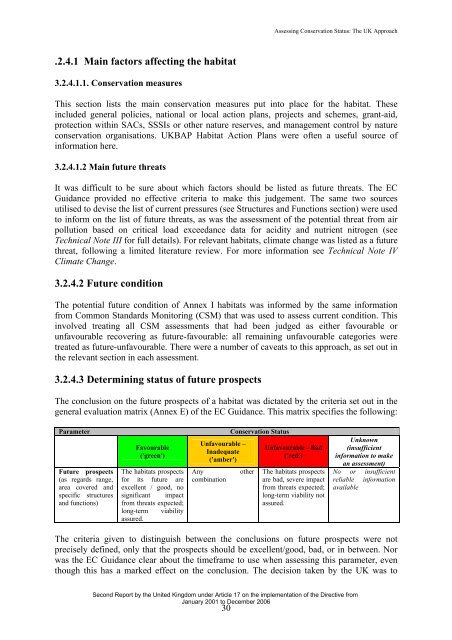Assessing Conservation Status: The UK Approach - JNCC
Assessing Conservation Status: The UK Approach - JNCC
Assessing Conservation Status: The UK Approach - JNCC
Create successful ePaper yourself
Turn your PDF publications into a flip-book with our unique Google optimized e-Paper software.
<strong>Assessing</strong> <strong>Conservation</strong> <strong>Status</strong>: <strong>The</strong> <strong>UK</strong> <strong>Approach</strong><br />
.2.4.1 Main factors affecting the habitat<br />
3.2.4.1.1. <strong>Conservation</strong> measures<br />
This section lists the main conservation measures put into place for the habitat. <strong>The</strong>se<br />
included general policies, national or local action plans, projects and schemes, grant-aid,<br />
protection within SACs, SSSIs or other nature reserves, and management control by nature<br />
conservation organisations. <strong>UK</strong>BAP Habitat Action Plans were often a useful source of<br />
information here.<br />
3.2.4.1.2 Main future threats<br />
It was difficult to be sure about which factors should be listed as future threats. <strong>The</strong> EC<br />
Guidance provided no effective criteria to make this judgement. <strong>The</strong> same two sources<br />
utilised to devise the list of current pressures (see Structures and Functions section) were used<br />
to inform on the list of future threats, as was the assessment of the potential threat from air<br />
pollution based on critical load exceedance data for acidity and nutrient nitrogen (see<br />
Technical Note III for full details). For relevant habitats, climate change was listed as a future<br />
threat, following a limited literature review. For more information see Technical Note IV<br />
Climate Change.<br />
3.2.4.2 Future condition<br />
<strong>The</strong> potential future condition of Annex I habitats was informed by the same information<br />
from Common Standards Monitoring (CSM) that was used to assess current condition. This<br />
involved treating all CSM assessments that had been judged as either favourable or<br />
unfavourable recovering as future-favourable: all remaining unfavourable categories were<br />
treated as future-unfavourable. <strong>The</strong>re were a number of caveats to this approach, as set out in<br />
the relevant section in each assessment.<br />
3.2.4.3 Determining status of future prospects<br />
<strong>The</strong> conclusion on the future prospects of a habitat was dictated by the criteria set out in the<br />
general evaluation matrix (Annex E) of the EC Guidance. This matrix specifies the following:<br />
Parameter<br />
Future prospects<br />
(as regards range,<br />
area covered and<br />
specific structures<br />
and functions)<br />
Favourable<br />
('green')<br />
<strong>The</strong> habitats prospects<br />
for its future are<br />
excellent / good, no<br />
significant impact<br />
from threats expected;<br />
long-term viability<br />
assured.<br />
Unfavourable –<br />
Inadequate<br />
('amber')<br />
Any<br />
combination<br />
<strong>Conservation</strong> <strong>Status</strong><br />
other<br />
Unfavourable - Bad<br />
('red')<br />
<strong>The</strong> habitats prospects<br />
are bad, severe impact<br />
from threats expected;<br />
long-term viability not<br />
assured.<br />
Unknown<br />
(insufficient<br />
information to make<br />
an assessment)<br />
No or insufficient<br />
reliable information<br />
available<br />
<strong>The</strong> criteria given to distinguish between the conclusions on future prospects were not<br />
precisely defined, only that the prospects should be excellent/good, bad, or in between. Nor<br />
was the EC Guidance clear about the timeframe to use when assessing this parameter, even<br />
though this has a marked effect on the conclusion. <strong>The</strong> decision taken by the <strong>UK</strong> was to<br />
Second Report by the United Kingdom under Article 17 on the implementation of the Directive from<br />
January 2001 to December 2006<br />
30
















